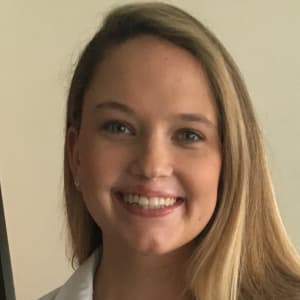
Brenna Harrington

Tahina Mukit
 Brenna Harrington |  Tahina Mukit |
Brenna Harrington, Tahina Mukit
Yu-Cheng Chang
Periodontics, University of Pennsylvania School of Dental Medicine
Introduction
Ankyloglossia, more commonly known as ‘tongue-tied,’ affects the ability to speak, eat and drink. Most often, this condition is treated during infancy or youth. Traditional treatment includes using a scalpel to relieve the lingual frenulum and sutures. Modern techniques utilize laser treatment for reliving the lingual frenulum. The aim of this case study is to evaluate the use of Er: YAG laser for lingual frenectomy in an adult patient.
Methods
Surgical consents were signed prior to the procedure. Pre-operative photos and tongue protrusion measurements were taken. The superior border of the frenulum attached to the ventral surface of the tongue was anesthetized with 0.5 capsules of 2% lidocaine with 1:100,000 epinephrine. The ventral surface of the tongue was retracted with 2x2 gauze, and light horizontal strokes were completed on the frenulum 4mm superior to the caruncle. Laser settings were 25PPS and 70mj with copious irrigation. This was done until the patient felt notable frenulum relief. Post-operative measurements were taken. Adequate hemostasis was achieved, and no sutures were placed. Post-operative instructions were reviewed, and the patient took 325mg acetaminophen for pain control. The patient returned for two weeks follow-up.
Results
Immediately following the procedure, the patient gained 12mm in tongue protrusion. At the two-week follow-up appointment, this 12mm extension decreased to 10mm, and 2mm in recoil was noted. However, the patient has not recognized this 2mm recoil. The patient experienced ulcerated healing on a postoperative Day 1 through Day 3. After Day 3, the patient noted only mild discomfort and ulcerated healing. On Day 14, the surgical slight almost completely healed. On day 21, the patient felt no discomfort.
Conclusion
Overall, the Er: YAG laser frenectomy worked exceptionally well in this clinical case report. Patient expectations were met as the patient was satisfied with the newly added mobility of her tongue. Only minor recoil was noted at the two-week post-operative appointment with this treatment method. Moreover, Er: YAG laser treatment achieved immediate postoperative hemostasis, and no sutures were needed. This greatly aids in patient comfort, postoperative pain control, and overall therapy acceptance. Further investigation is warranted to compare Er: YAG laser with other laser options, such as CO2 and Nd: YAG lasers.